| |
Strawberry Fields for Winter
Last weekend, I had to make dessert for a dinner party. Wanting to do something with fruit, I headed to the produce section, thinking about citrus or maybe pears. Those thoughts were blown out of my head by the sight of row upon row of . . . bright red strawberries. And a big sign proclaiming the arrival of the "Strawberry Fair." In Japan, winter is the high season of the strawberry. Strawberries sit in little boxes in displays at the front of the store, announcing their provenance and price ("Fresh Strawberries from Sendai! 680 yen!"), drawing attention away from all the other fruits. Every patisserie sets out an array of strawberried treats ― filled, topped, stuffed with jam, you name it. Strawberry KitKats, strawberry danish, and strawberry eclairs are everywhere. Traditional sweets, like daifuku ( anko-filled mochi balls) contain strawberries at this time of year, too. The prominence of strawberries in January is very strange to me because, as for most Americans, strawberries scream "summer!" It seems somehow wrong to see them everywhere when we're still rocking our snowboots every day. A bit of research revealed that in many parts of Japan, strawberries alternate with rice as a part-of-the-year crop, so it's not completely out of the question that they would be reaching peak over the winter months. In fact, the strawberries we've eaten were grown in Japan and were quite delicious. On the other hand, it makes me think: perhaps the strawberry producers are in cahoots with the weathermen ("If we sell strawberries during the winter, they'll make people think of summer! They'll forget that the temperature hasn't gotten above freezing in six days, and all will be right as rain!).
Let's take a look at today's weather, shall we? Here's the weather report. It's pretty typical for winter in Tohoku: snow in the morning, and cloudy all day after that. 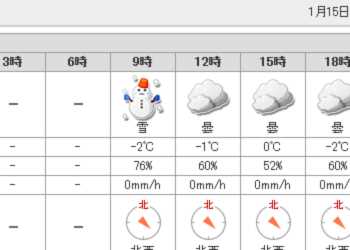 Now, let's take a look out the window: 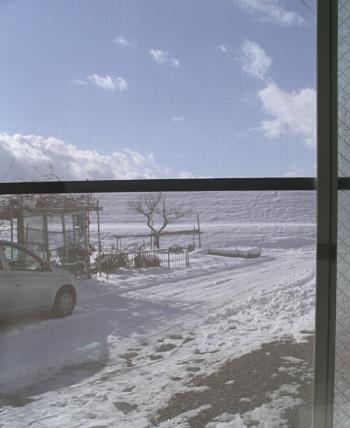 That's about how it goes with the weather forecasts here. They aren't just inaccurate, they're willfully dishonest, or at least it seems so. My theory is that the weathermen are part of a secret government program to emotionally control the people and prevent revolt. When it's nice out (or will be), the forecast shows nasty weather, so that everyone gets a pleasant surprise and is happy. When it's nasty out, the forecast shows nice weather tomorrow or the next day, which gives people hope (even though the nice weather doesn't actually arrive until three weeks later).
Many people in Japan, male and female alike, hang multiple small mascots from their keitai (cell phones). Mascots range from characters associated with the phone company to well-known comic, manga, or anime characters. I've only got one on my cute pink phone. 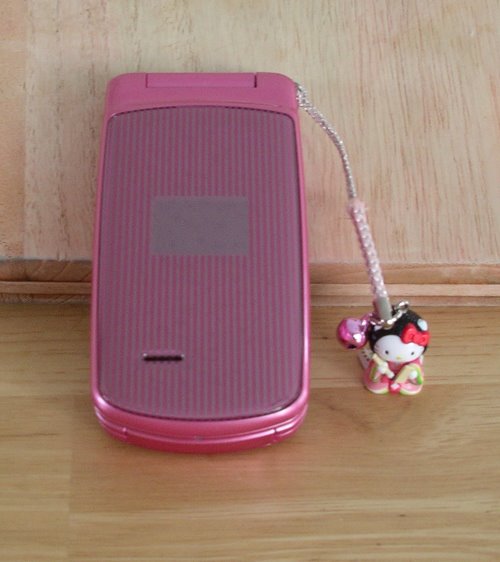 It's Hello Kitty, of course, but she's special. Sanrio makes Hello Kitty merchandise specific to each of the prefectures, representing events or products for which the prefecture is known. This Kitty-chan represents the famous Heian period poetess, Komachi, who according to legend was from what is now Akita Prefecture. Komachi was also regarded as a great beauty, which Matthew thinks makes her name particularly fitting for the Akita Shinkansen. 
To make the most of our Japan experience, we've been choosing to participate in Japanese traditions, rituals, and events as much as possible. For New Year's Eve, that would have meant a quiet evening at home and a trip to the temple or shrine at or around midnight. Then a friend told us that there would be a more festive celebration at American World, one involving fireworks. Being Westerners, we like fireworks on New Year's. So, the three of us bundled up for the frigid night ahead and made our way to American World. Much to our relief, events started indoors with a live variety show featuring impersonators of famous Japanese performers. There were also a number of cosplayers (people wearing full costumes of their favorite anime or manga characters). The show was totally fun, and probably would have been even better if we knew the personalities involved. On the other hand, how can you not love seeing a manic guy sing "Livin' La Vida Loca" in Japanese? At one point, an enka song began playing. We knew an impersonator would perform the traditional music, with its themes of love, loss, hardships, and loneliness. We did not, however, expect this: 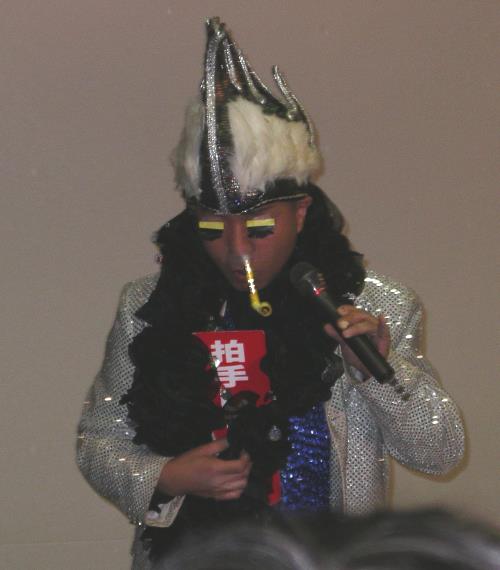 There were also a bunch of people running around in mouse costumes to celebrate the upcoming Year of the Rat/Mouse. It made Matthew feel like he was in a Monty Python sketch. After the show, we were herded outside into the cold, cold, Tohoku night to await the fireworks. About ten minutes into our half-hour wait, organizers started a bonfire in the parking lot ― ahh, blessed heat. I think the girls wearing short-shorts, knee-high socks, and parkas were also grateful for the bonfire. Somewhat inexplicably, there were also a few practice runs for the countdown (in Japanese) to the "Happy New Year" (in English) shout. It must have paid off, because both went off without a hitch. Yay, 2008! Also, yay, fireworks! They were very cool, and much more like an American fireworks display than the two-hour extravaganza for Michinoku Geinou Matsuri (which was good because, well, cold). Fireworks were followed by the organizers tossing balls of mochi into the crowd for good luck. We are not good at catching mochi. Once the events were over, we retired to the house with some local friends. Matthew made amazake, a warm, sweet fermented rice drink, and we ate black sesame and walnut mochi made by the neighbor across the street. Sitting with our feet under the kotatsu with friends new and old, and the dogs lounging nearby, was a perfect way to spend the early moments of the new year, traditional or not.
Nengajou are traditional New Year's postcards in Japan. They are sent to arrive on or after New Year's Day. It's even considered rather awkward if they arrive early! Late is okay, but it's really best for them to arrive on January 1. For this reason, the post office has a special system set up. When correctly marked as a nengajou, cards are set aside for special handling. Then on New Year's Day, they mobilize thousands of extra employees to deliver all the cards on the same morning. There's a long tradition of handmade cards. In the month before New Year's you can buy blank postcards, which you can decorate by hand with stickers and rubber stamps. You can also use a stencil machine, print them from your computer, or simply draw them by hand. Recently, there are also services in camera shops and on the internet to order your own custom designs. People without such creative inclinations can buy them with pre-printed designs. This year, instead of Christmas cards, we decided to send out nengajou. We used stickers and rubber stamps to decorate ours. A nice feature of making them by hand is that it's easy to make each one unique. 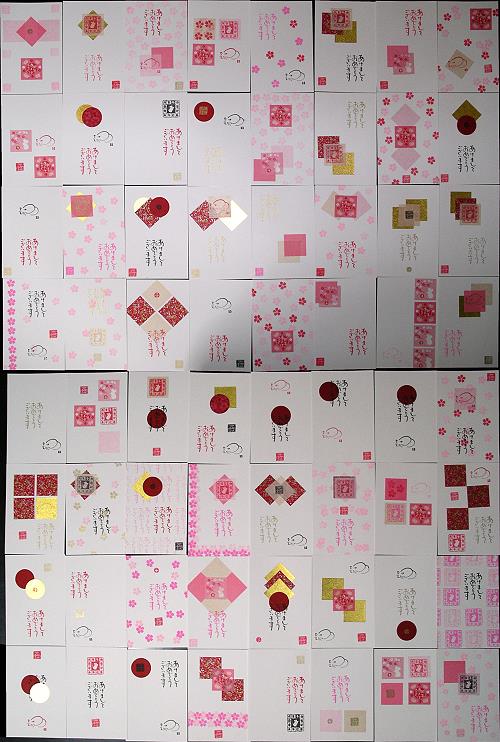 And here's a closeup of one card. 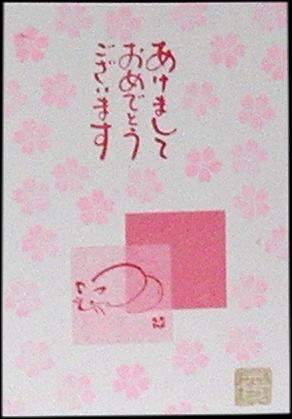 2008 is the "Year of the Rat" on the Asian calendar. There doesn't seem to really be much distinction between mice and rats here (the Japanese word for mouse is actually "small rat"), so it's really treated as the Year of the Mouse. That's why there are all the cute little mice on our nengajou.
[ 4 comments ] permalink
We've both been here long enough to have unusual experiences and eat unusual things. On the eating front, they've almost always been things we've chosen to eat ― nobody really springs freaky stuff on the unsuspecting gaijin. For example, one night at Hige-oyaji's place, he started showing us some more adventurous Japanese foods, including hizunamasu, a Hokkaido regional specialty. Hizunamasu is thin slices of pickled salmon head, cartilage and all. I rather liked it; it makes a nice accompaniment to a mug of beer. He also showed us his big jar of shiokara, which Wikipedia defines as "small pieces of the [sea] animal's meat in a brown viscous paste of the animal's heavily salted, fermented viscera." It's frequently served with shots of sake, perhaps to no one's surprise after that description. We'd gone there a number of times before that night, so we assumed that he'd only busted out the potentially yak-inducing fish preparations because he knew us well enough to know that we wouldn't gag or otherwise freak out. So it was with little or no trepidation that we visited a new-to-us fish restaurant earlier this week. The owner/chef had a pretty standard set of dishes on his menu: nabe teishoku (hotpot served with rice, pickles, and another side of some type); grilled fish teishoku (same thing, but with grilled fish in place of the hotpot and with miso soup); fried fish, maybe an oyster stew. Matthew ordered the seafood nabe teishoku, I went with grilled fish. Things were proceeding as they usually do until we were served. Then the following conversation took place: MAD: I don't know how to eat a whole fish head. SKD: Oh, farm. Is that shiokara? Indeed, on our trays sat little bowls of shiokara, apparently a standard teishoku dish at this restaurant. We ate our other things, glancing at the ruddy brown dish every now and again. Finally, we each bit the bullet and tried it without the benefit of sake because we still had work to do. And. . . it wasn't half bad ― it was quite salty, and tasted rather like fishy miso with bits of squid in it. Mostly, it was a good reminder of what should be the motto for our lives here: expect the unexpected.
Friday, December 14, 2007, 6:08 PM Strange JapanPosted by stefanie Yesterday afternoon, Matthew and I ate lunch at our favorite takoyaki joint and watched the news on Japanese television. At three o'clock, the news broke and a cheery woman at a piano, along with three young women wearing cute gray hoodies and boy shorts, appeared. The woman played the piano while the young women demonstrated a set of stretches, which they then put together as a short calisthenics routine. Nothing terribly taxing, just a bit of exercise, or radio taiso, to get the blood moving after lunch. I had heard about radio taiso from my Japanese teacher in America. It apparently started as an effort by the Japanese government to keep people from being totally sedentary during the day, and continues on NHK. Some companies, like the concrete plant across the street from our house, still do it in the mornings. It does sound like a good way to keep alert and well-stretched ― provided you're not stuffing your face with okonomiyaki at the time it comes on.
Sponge cakes with strawberries, whipped cream, and placards
Cheesecakes with gold dust for holiday snackers
Chocolate yule logs with Santas and sleighs
These are a few of the cakey displays . . . Here in Japan, no Christmas is complete without a Christmas cake. Christmas cake is traditionally sponge cake with whipped cream and strawberries. It has morphed into far more extravagant things, like cheesecakes or chocolate cakes covered in ganache (melted chocolate mixed with cream, and sometimes liqueur). You can also get them decorated with white chocolate Mickey-head plaques or holiday wishes from Kitty-chan. Grocery stores, conbini, and patisseries have had these glossy brochures out for about three weeks now, advertising their scrumptious holiday wares. 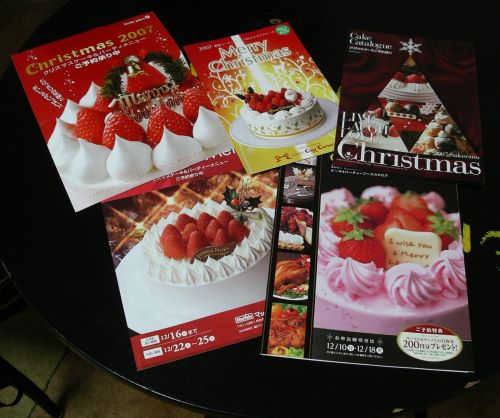
[ add comment ] permalink
Saturday, November 17, 2007, 1:15 AM Strange JapanPosted by stefanie "Okame, kame, kame, uma nat-TOU!"
The music in Japanese grocery stores is insidious. It's not like the Muzak/adult contemporary/soft rock stuff that plays in American grocery stores. It's more like 1970s game show music interspersed with 1950s product jingles, on constant loop. And each store has its own unique selections, further lending to the ambiance of the store (e.g., the JOIS has the checkers wearing mint-green flight attendant uniforms AND sounds like the set of "The Price is Right").
Additionally, there often will be tape recorders scattered throughout the store, eternally playing advertisements for whatever product they're nearest to. The nattou ad at the nearby grocery store is especially fiendish. You say, "I have the nattou song from the Big House stuck in my head," and everyone knows what you mean. And then they sing along.
"Okame, kame, kame, uma nat-TOU!"
[ 2 comments ] permalink
Wednesday, November 7, 2007, 2:11 AM Strange JapanPosted by stefanie I'm afraid of the dark. It doesn't take much to freak me out at night, especially here, where the streetlights are few and far between. On my way to meet Matthew for dinner after work one night, I had a frightening experience that I recall even now, whenever I hear a specific sound.
I was crossing the large street near our house when I first saw the unmarked white truck. It had a red lantern hanging off the back, and played an eerie bamboo flute melody over and over. Low, then high, then low to high again, trilling. It passed me, and I crossed the street, thinking what a curious thing it was. As I walked alone through the darkened streets toward Matthew's office, I heard the melody again. And again. Over and over, low to high, haunting. One street over, the unmarked white truck with the red lantern moved in parallel.
After a few more repetitions of the melody, I started to get nervous. The streets were empty, save for me and the lantern truck. For a city, Kitakami is remarkably quiet, which made the mysterious flute even more unnerving. And it was dark, and the streets were unfamiliar, so I couldn't escape it by choosing an alternate route. I kept moving.
Walking. Red lantern glowing, one street over. Flute playing, haunting, low to high. What was this thing, and why was it stalking me?
By the time I reached the school, my nerves had mostly receded, along with the music. As I told Matthew and his co-worker my scary tale, the music began again, drawing closer. The truck crawled into sight, red lantern glowing, slowing to a stop below the window. It had come:
The mobile ramen shop.
[ 6 comments ] permalink
Back Next
|
|








 Calendar
Calendar




